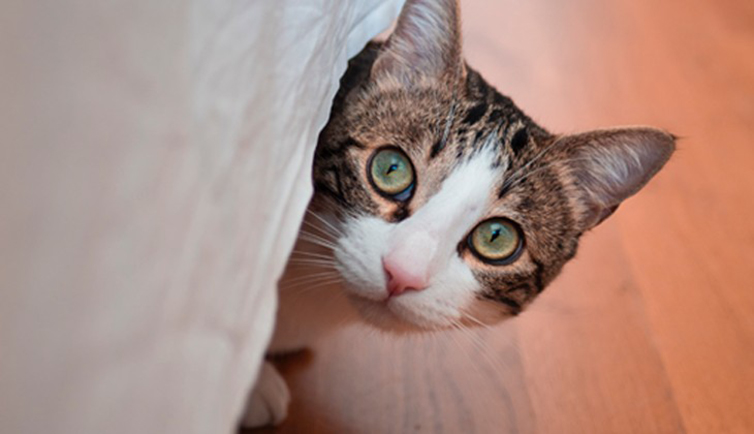Fears and Phobias in Your Furry Friends
One summer morning, the Nielson family decided to take their lively cocker spaniel pup, Milo for a hike. As usual, Milo ran the length of his leash, sniffing his way off the trail into the shrubbery to uncover every hidden scent he could find. But today was different because Milo’s adventures resulted in injury when the end of a grass seed lodged deep within his ear canal. As soon as the family realized something was wrong, they rushed Milo to the vet to have the painful grass piece removed. The vet also prescribed antibiotics to prevent infection. The Nielsons assumed all was well but Milo’s personality seemed to change almost immediately. He became attached to Mrs. Nielson and refused to go for walks or even put on his leash at all. It was clear that his injury had caused some kind of emotional impact and the Nielsons were left trying to figure out how to help their furry companion to overcome this trauma.
HEALTH AND WELLNESS

Posted by bravectosouthafrica – 12 February 2021
Emotional Trauma in Dogs and Cats
Like humans, pets can develop fear and anxiety disorders. An unpleasant experience early in life can sometimes be the cause of these emotional issues. These situations can range from abuse and abandonment, to thunderstorms and even car accidents and fireworks. They can also be experiences that the pet perceived as unpleasant, such as having his or her nails clipped or being bathed or, like Milo, a painful injury incurred while on walkies.
But an unpleasant experience isn’t the only cause of a pet phobia. If a pet is not exposed to something during the sensitive period of development (up to 3 months of age for dogs and 2 months for cats), – for example people, places, sights or sounds – those unknown things may become fear-evoking stimuli. For example, if a dog or cat has only encountered adults during his or her early development, a first meeting with children can be a scary thing.
Separation anxiety and genetics can also present significant emotional trauma for many pets, contributing to fear levels, phobias and reactions to stimuli.
Signs of Fear in Cats
Cats display very specific signs of fear or stress. Some cats may hide or try to make themselves look as small as possible by pulling their ears back and remaining still. Other cats may become agitated or aggressive. Signs of aggression include dilated pupils, arched back, raised hair, tail whipping back and forth and hissing.
Signs of Fear in Dogs
Dogs express fear in many ways such as pacing, whining, barking or even visibly shaking. They may cower or hide or, like our friend Milo, retreat from activities that once were normal and loved. Some dogs may also appear aggressive. This is usually a behaviour known as “fear reactivity,” which essentially means the dog is acting aggressively when in fact, he is scared.
Treating Emotional Trauma in Pets
Unlike humans who suffer emotional trauma, our pets can’t tell us about their feelings. Experts generally focus on what is known as “desensitization and counter-conditioning.” Desensitization is the process of slowly exposing the animal to their fear stimuli in a safe, non-threatening environment. This exposure increases gradually and through this process, the pet learns that the event is not actually negative. They become “desensitized” to the stimulus.
Let’s take Milo as an example. After his injury, he ran and hid every time the leash appeared. Eventually, the Nielsons managed to put the leash on him but instead of increasing his stress with a walk, they just let him walk around the house with his leash dragging behind him. They did this several times until Milo allowed them to open the front door and walk out onto the patio. They repeated this small step several times and eventually, increased the walk to the end of the driveway. Gradually, Milo’s walk increased until he could walk without fear down the street. Milo is slowly learning to love walkies again.
There are also a number of products that can help calm an anxious or emotional pet. The thundershirt, for example, provides gentle compression around your dog or cat’s body and is said to have a calming effect. Other items such as treat puzzles to keep them busy, herbal remedies and music can be effective for some animals. There are a range of playlists available online to aid in desensitization.
Sometimes a pet’s fear can be so significant that they may need pharmaceutical help to calm down and get started with re-training. In these cases, a veterinarian may prescribe drugs such as anti-depressants to complement behavioural therapy, reduce fear and improve quality of life. Be sure to seek your vet’s advice before giving your pet any drugs.
Living With a Traumatized Cat or Dog
In many cases, treatments like the above are successful. But with some pets, the psychological and physiological traumas are significant enough that the cat or dog may only respond partially to treatment, or not at all. Either way, it’s important to understand how to accommodate your emotionally sensitive companion and plan a treatment that works best for them.
A traumatized animal has a much-higher likelihood of becoming re-traumatized if it re-encounters major stressors. It’s a good idea for you to understand your furry friend’s triggers to help prevent further emotional episodes. This does not mean being overly-protective, but when possible, anticipate foreseeable stressors and try to avoid them. If the Nielsons were to immediately force Milo to take a walk, the emotional damage could worsen.
A common misconception in caring for a traumatized pet is that showering your four-legged friend with reassurance is all that they need to overcome the fear. This, along with giving your dog love in stressful situations, reinforces the fearful behaviour as you are rewarding their negative behaviour. Some dogs will learn to anticipate a stressful situation when they hear words like “good boy,” because they have learned to associate those words with a negative event, like going to the veterinarian.

In addition, experts advise that you should never use techniques that may frighten them. This includes noisy objects, spray bottles or anything that shocks the animal. This can be highly-detrimental to your pet emotionally and could make him or her aggressive.
It is most important to remember that there is always hope for your furry friend. Making sure that you remain calm, relaxed and cheerful will go a long way toward helping your furry companion. Monitor your own tone of voice – your fur child can recognize your own stress. You should also know that you are not alone in dealing with an emotionally traumatized pet – vets deal with emotionally-damaged animals on a daily basis and there are behaviourists that can also assist in extreme cases.
As for Milo, he has still not made it back to the hiking trail, but he has made some new doggy friends on his daily walks up and down the road.
Subscribe to our Newsletter
Get to know your furry friend better! Sign up for all things dog- or cat-related.
The Hairy Facts about the dreaded hairball
12 April 2021
Help! My dog’s barking mad! Volume 2
12 April 2021
Your Itchy, Scratchy Cat – All About Cat Skin Problems
12 April 2021
The Dog’s Diet: A Bone of contention?
01 April 2021
Mango Fly Worms: How to Spot and Eliminate them
Posted on November 28,2019
Managing Mange And Mites In Your Dog
Posted on June 11,2018
Why Do Cats Purr and How? Learn What Your Cat Is Saying
Posted on October 14,2020
How to Get Rid of Ear Mites in Dogs
Posted on November 06,2019









